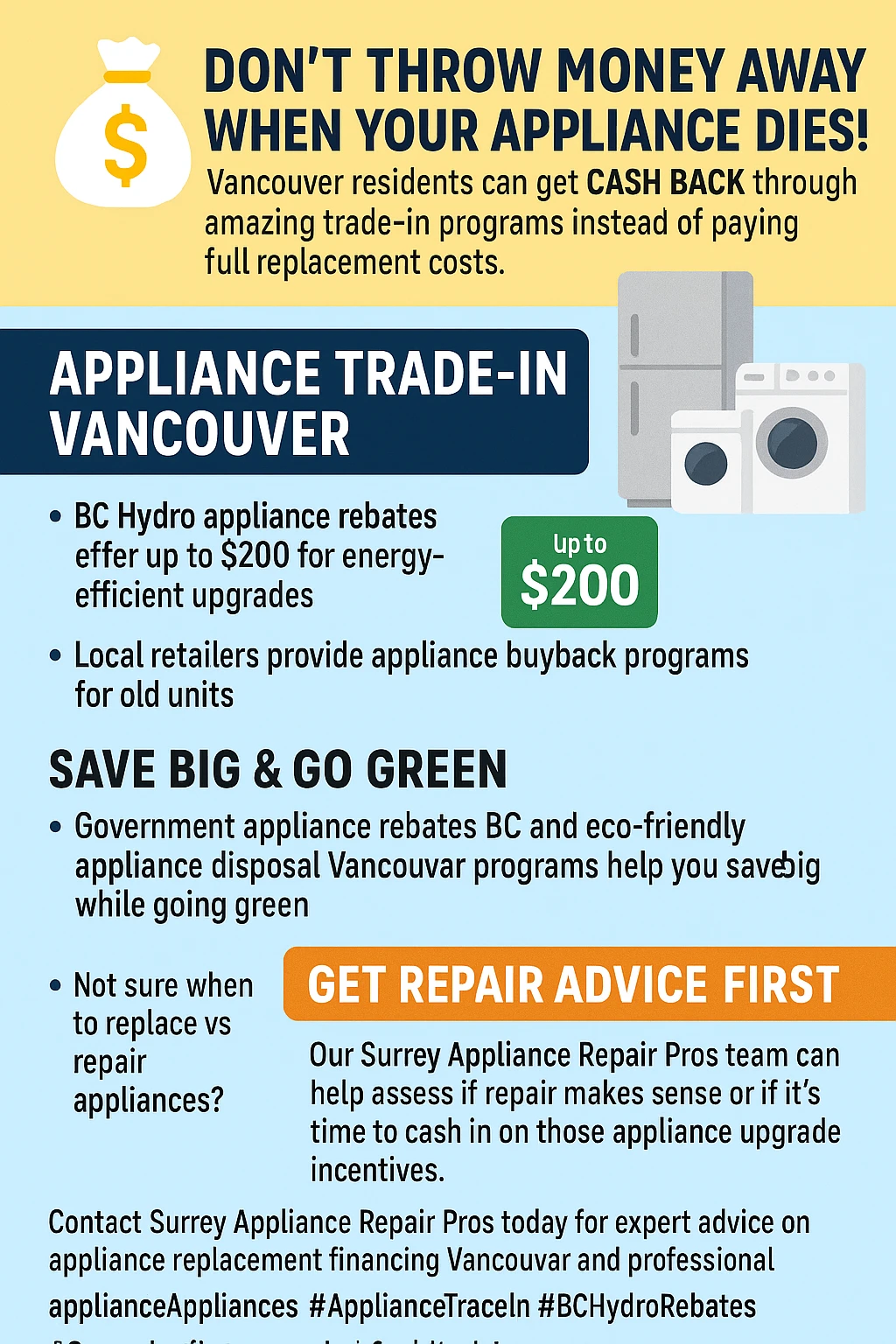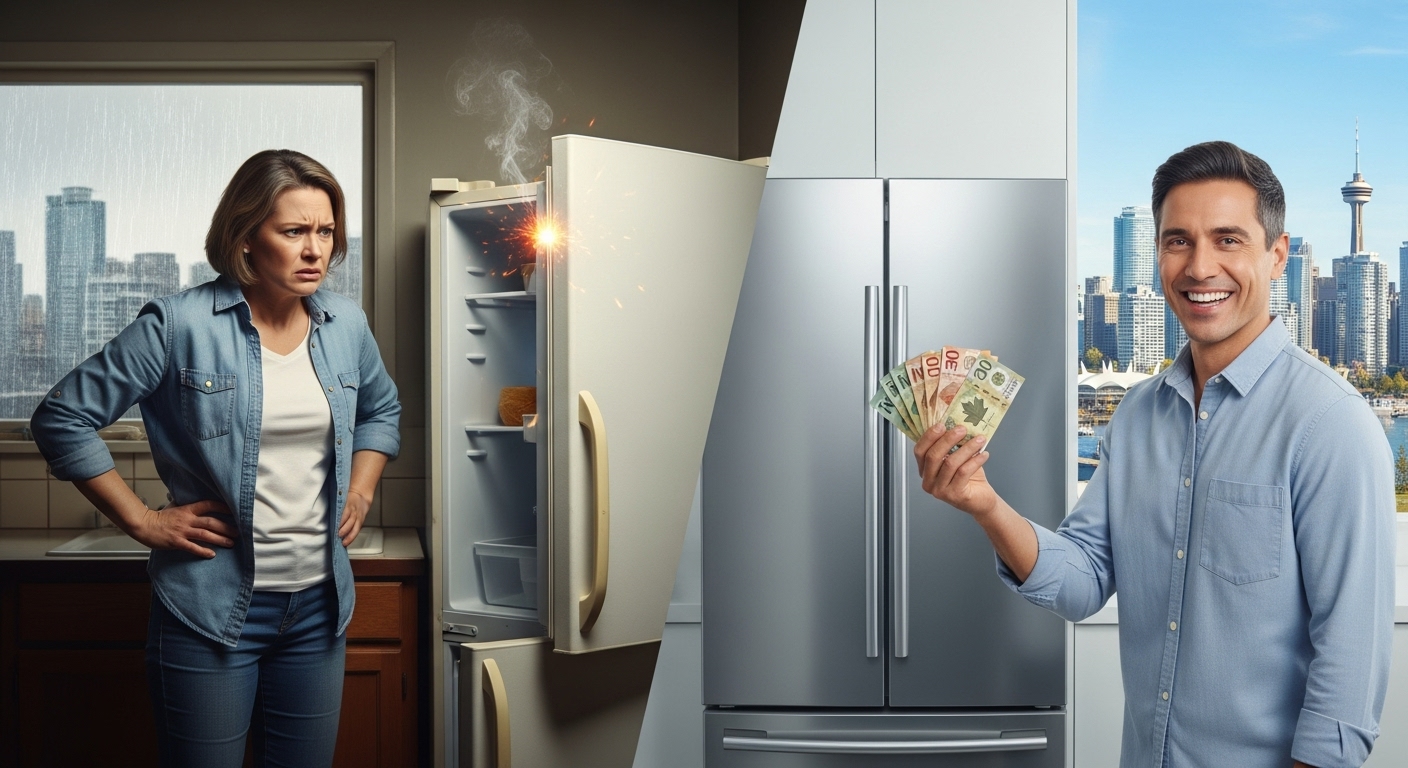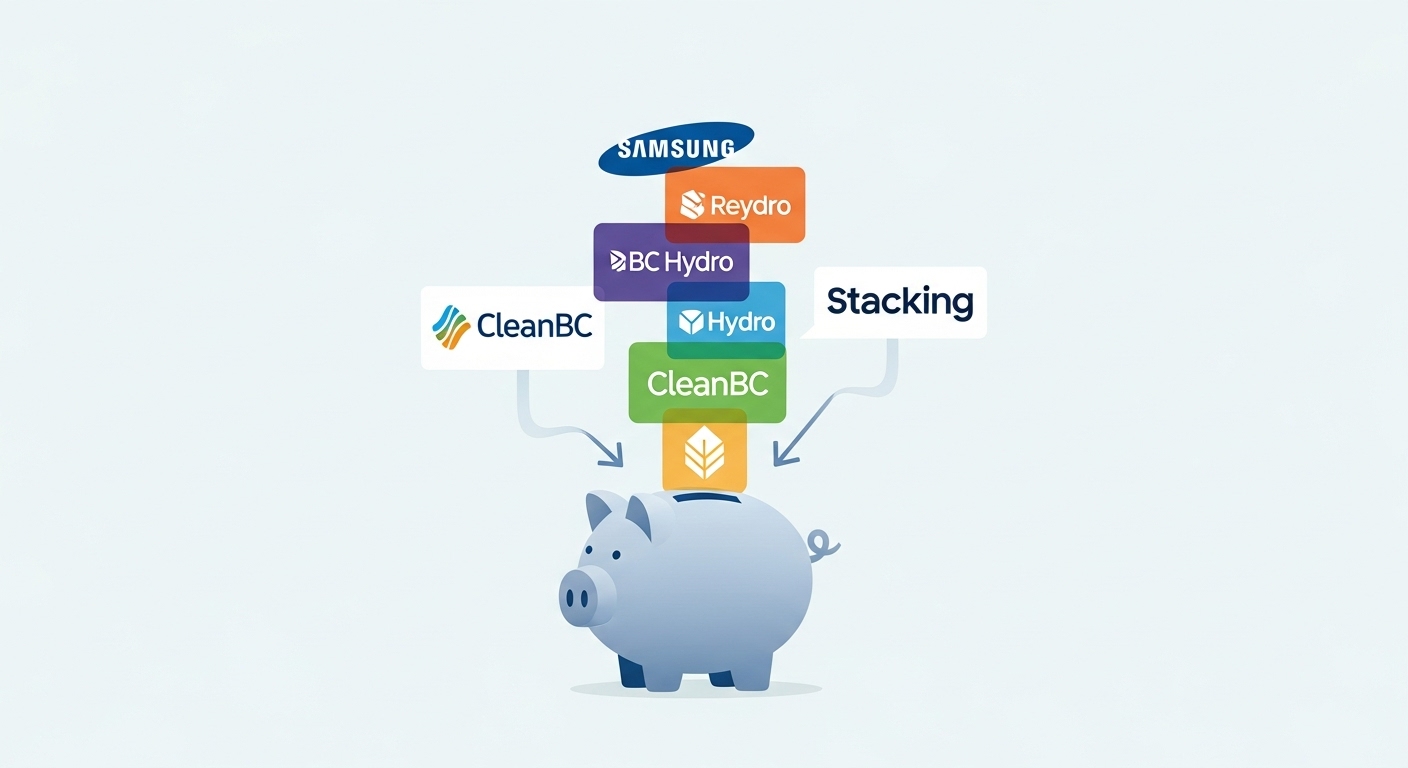Vancouver Appliance Trade-In Programs: How to Get Cash Back When Your Appliance Dies (Instead of Paying Full Price for Replacement)
Tired of your ancient fridge making that weird grinding noise at 3 AM, but dreading the sticker shock of replacement costs? What if I told you Vancouver residents can actually get paid up to $500 to upgrade their dying appliances instead of paying full price for new ones?
Picture this: your 15-year-old dishwasher finally gives up the ghost, leaving you with a sink full of dirty plates and the sinking feeling that your weekend budget just got obliterated. But here’s the plot twist – instead of frantically scrolling through Craigslist for the cheapest replacement, you could actually walk away with cash in your pocket while upgrading to a brand-new, energy-efficient model. It’s like finding out that spinach actually tastes good when you cook it right, except way more financially rewarding.
Vancouver’s appliance trade-in landscape is honestly kind of incredible once you know how to navigate it. We’re talking about a perfect storm of manufacturer incentives, provincial rebates, and utility programs that can stack together like the world’s most boring but profitable Jenga tower. The trick is understanding when to pull the trigger on replacement versus repair, how to time your purchases with promotional windows, and which programs you can combine for maximum savings.
The reality check? BC Hydro estimates there are close to 500,000 spare fridges in homes across the province, costing British Columbians up to $42 million a year in electricity costs. That’s not a typo – we’re collectively hemorrhaging money on inefficient appliances while missing out on programs designed to pay us to upgrade. It’s time to flip the script.
Key Outtakes:
- Vancouver residents can save $30-$500 per appliance through combined trade-in programs and rebates from retailers like Samsung, BC Hydro deals, and provincial CleanBC initiatives
- The 50/50 rule determines optimal replacement timing: if repair costs exceed 50% of new appliance price and the unit has reached 50% of expected lifespan, replacement wins financially
- BC Hydro’s buyback program alone has recycled over 250,000 refrigerators since 2007, saving customers more than $23 million in electricity costs
- Strategic program stacking can reduce replacement costs by up to $950+ when combining retailer trade-ins with utility rebates and provincial incentives
- Proper maintenance documentation, including professional dryer vent cleaning, can prevent 15,970 annual appliance fires while increasing trade-in values by $200-$400

Understanding Vancouver’s Appliance Trade-In Landscape

Let’s dive into the meat and potatoes of what’s actually available in our neck of the woods. Vancouver’s trade-in scene isn’t just your typical “bring in your old toaster for $20 off” situation – we’re looking at serious money-back programs that can make the difference between a budget-busting emergency purchase and a strategic upgrade that actually saves you cash.
The heavy hitters in the retailer game are putting some real skin in the game. Samsung’s Trade-Up Program is offering $75-$500 based on your purchase amount, with the sweet spot being purchases over $3,000 that net you the full $500 credit. The catch? You need to trade in the same category – fridge for fridge, washer for washer – and the program runs specific promotional windows like their current March 13-April 9, 2025 timeframe. Best Buy takes a different approach with their instant gift card valuation system right at the customer service desk, and the beauty is that these gift cards never expire, so you can time your purchase strategically.
On the provincial and utility front, things get really interesting. BC Hydro’s current appliance deals program runs from October 3, 2025 through January 2, 2026, offering $75 off ENERGY STAR refrigerators that are 15% more efficient than federal standards, plus $50-$150 off dryers based on their Combined Energy Factor ratings. If you’re lucky enough to live in specific FortisBC service areas like Grand Forks, Penticton, or Nelson, you can snag up to $250 rebates for Energy Star washers and dryers. The CleanBC Better Homes program is where things get wild – we’re talking up to $14,000 for comprehensive home appliance upgrades including heat pumps and water heaters.
Local Vancouver businesses are getting in on the action too. Electra Appliance Gallery has built their whole trade-in program around personalized assessments – you send them photos or model numbers and they come back with competitive offers. It’s like having a personal appliance sommelier, except instead of wine pairings, they’re helping you maximize your trade-in value. The key insight here is that timing is absolutely everything in this game, and the businesses that understand seasonal demand patterns are the ones offering the most aggressive incentives during off-peak periods.
Government Rebate Programs and Incentives

Now we’re getting into the government money territory, and honestly, this is where Vancouver residents can really clean up if they know how to work the system. The province and BC Hydro aren’t just throwing around pocket change – they’re offering substantial rebates that can fundamentally change the math on appliance replacement.
BC Hydro’s Appliance Deals Program works with 10 participating retailers including Canadian Appliance Source, Coast Appliances, Home Hardware, Leon’s, Midland Appliance, RONA, The Brick, Home Depot, Trail Appliances, and Visions Electronics. The beauty of this system is that you get instant discounts at point of purchase, but if you buy from a non-participating retailer, you can still apply for post-purchase rebates as long as you submit your application by March 3, 2026. They cap it at two units per appliance type per customer transaction, which prevents people from gaming the system but still allows for reasonable household upgrades.
The BC Hydro Fridge Buy-Back Program is probably the most straightforward cash-for-clunkers deal you’ll find. They literally pay you $30 cash per spare refrigerator they collect, and here’s the kicker – they’re targeting those 500,000 estimated secondary fridges in BC homes because each one costs up to $150 annually to operate. Since 2007, they’ve collected over 250,000 fridges, saved customers $23 million in electricity costs, and freed up enough energy to power a city the size of Chilliwack for an entire year. That’s not just feel-good environmental messaging – that’s serious money staying in residents’ pockets.
CleanBC Better Homes is where the really big money lives. Heat pump conversions can net you up to $6,000 for ductless mini-split or central ducted systems when you’re converting from fossil fuels. Electric heat pump water heaters qualify for $1,000 rebates when converting from gas, oil, or propane. They’ve got this Two Upgrade Bonus that throws an additional $300 your way when you complete multiple upgrades, plus a Home Energy Improvement Bonus worth up to $2,000 for comprehensive efficiency improvements. The paperwork deadline is crucial though – applications must be submitted within 6 months of your invoice date or by August 31, 2025 for programs that have already expired.
Energy Star certification isn’t just a nice-to-have sticker – it’s your gateway to the rebate kingdom. Refrigerators need to be 15% more efficient than federal standards, which excludes compact, built-in, and single-door units. Clothes washers need an Integrated Modified Energy Factor (IMEF) of 2.92 or higher and an Integrated Water Factor (IWF) of 3.2 or lower. Dryers are tiered by Combined Energy Factor – 4.3-5.4 CEF gets you $50, and 5.4 or higher gets you $150. Dishwashers need to meet a 3.5 kWh annual energy consumption rating to qualify. It’s a numbers game, but knowing these numbers is how you win.
Retailer-Specific Programs and Stacking Strategies

This is where the real art of the deal comes into play – stacking offers like a pro. Retailers are competing for your business, and that means you’ve got leverage. The goal isn’t just to get one discount; it’s to create a cascade of savings that can slash your final bill in half.
Let’s do some math. Say you’re buying a $3,500 Samsung fridge, washer, and dryer package during their promotional window. You’ll get the maximum $500 trade-in credit from Samsung. The fridge is Energy Star certified, so you get another $75 off instantly from BC Hydro. The dryer has a CEF over 5.4, so that’s another $150 off. We’re already at $725 in savings before you’ve even left the store. Now, let’s say your old fridge qualifies for the BC Hydro Buy-Back program – that’s another $30 cash. If you’re swapping out a gas dryer for that new electric one, you could be eligible for a FortisBC rebate of up to $250. We’re now at a total savings of $1,005 on a $3,500 purchase. That’s a 28% discount just for knowing which programs to stack.
The key is to pay attention to timing. Major retailers like The Brick and Leon’s often run “Save the Tax” events that can be stacked with manufacturer and utility rebates. Home Depot and Lowe’s have been known to offer 10-15% off appliance packages during holiday weekends like Victoria Day or Labour Day. The absolute golden rule is to always ask the salesperson about stacking eligibility. Some retailer-specific discounts might not combine with other offers, so getting clarity upfront is crucial.
The 50/50 Rule: When to Repair vs. Replace
Okay, let’s address the elephant in the room: when do you actually pull the plug on your old appliance? The 50/50 rule is the industry gold standard for this decision. It’s simple: if the cost of the repair is more than 50% of the cost of a new appliance, and your current unit is more than 50% through its expected lifespan, it’s time to replace.
Here’s a quick cheat sheet for average appliance lifespans:
- Refrigerators: 10-18 years
- Dishwashers: 8-15 years
- Washing Machines: 8-14 years
- Dryers: 10-13 years
- Microwaves: 5-10 years
Let’s say your 10-year-old washing machine needs a new motor, and the repair quote is $450. A comparable new washer costs $800. Since the repair cost ($450) is more than 50% of the new price ($400), and the washer is well into its second half of life, the 50/50 rule screams “REPLACE!” This is especially true when you factor in the potential savings from trade-in programs and rebates, which can often bring the cost of the new appliance down to the same price as the repair, but with the added benefit of a new warranty and better energy efficiency.
Maximizing Your Trade-In Value: The Pro-Tips

You wouldn’t sell a car without washing it first, right? The same logic applies to your appliances. A little bit of prep work can significantly boost your trade-in offer, especially with retailers who do a visual assessment.
First, give it a deep clean. We’re talking inside and out. For a fridge, that means clearing out all food, wiping down shelves, and cleaning the exterior. For a washer, run a cleaning cycle with vinegar or a specialized cleaner. A clean appliance looks like a well-maintained appliance, and that translates to a better offer.
Second, gather your documents. If you have the original owner’s manual, receipts, or any maintenance records, bring them. Proof of professional dryer vent cleaning, for example, is a huge plus. According to the U.S. Fire Administration, there are an estimated 15,970 appliance fires annually, with dryers being a primary culprit due to lint buildup. Showing a record of professional maintenance demonstrates that you’ve taken care of the unit and mitigates perceived risk for the retailer, which can add $50-$100 to your trade-in value.
Finally, know your appliance’s specs. Have the model number, serial number, and age ready. This allows the retailer to quickly look up its value and streamlines the entire process. The easier you make it for them, the more likely you are to get a competitive offer.
FAQs About Vancouver Appliance Trade-In Programs
Can I trade in an appliance that is not working?
Absolutely. Most programs, especially the utility-run buy-back programs, are designed to take non-functional appliances out of circulation. Retailer programs may offer less for a completely dead unit, but it will still have some value, especially if it’s a recent model.
Do I need to bring the old appliance to the store myself?
It depends on the program. Retailers like Samsung, The Brick, and Leon’s typically include haul-away of your old appliance as part of the delivery service for your new one. BC Hydro’s Fridge Buy-Back program will literally send a team to your house to pick it up for free. Smaller retailers might require you to bring it in, so always clarify the logistics beforehand.
Can I stack a retailer’s trade-in offer with BC Hydro rebates?
Yes, in most cases. BC Hydro rebates are often applied at the point of sale by participating retailers, and these can usually be combined with the retailer’s own promotions. The key is to confirm with the salesperson, as some specific store-level discounts might have exclusions.
What happens to the old appliances that are traded in?
The vast majority are recycled. BC Hydro, for instance, works with the Major Appliance Recycling Roundtable (MARR) to ensure that 95% of the materials from the collected fridges are recycled. This includes properly draining and disposing of ozone-depleting refrigerants and other harmful chemicals, making it an environmentally responsible choice.
Wrapping Up: Turning Your Dead Appliance into a Discount
The next time your dishwasher starts making sounds like a dying whale, don’t panic. In Vancouver, a broken appliance isn’t a financial disaster – it’s an opportunity. By understanding the landscape of retailer trade-ins, BC Hydro rebates, and CleanBC incentives, you can turn that clunker into a significant down payment on a new, more efficient model.
The key is to be strategic. Know the 50/50 rule, time your purchases with promotional periods, and don’t be afraid to stack offers. A little bit of research and a few pointed questions can easily save you hundreds, if not thousands, of dollars.
So, take a look at that old beer fridge in the garage. It’s not just taking up space and sucking up electricity – it’s a $30 bill waiting to be collected. In the world of Vancouver appliances, it pays to be an informed consumer.

